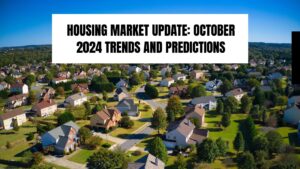Are you dreaming of owning a home, but the current housing market feels more like a battlefield than a buyer's paradise? Don't worry, you're not alone! In today's competitive housing market, securing your dream home requires more than just a good credit score and a healthy savings account. It demands strategy, quick thinking, and a bit of savvy. This article will equip you with five buying tips to outsmart the competitive housing market and find the perfect place to call home.
5 Tips for Buyers to Outsmart the Competitive Housing Market
Key Takeaways:
Before we dive into the details, let's highlight the key takeaways that will serve as your roadmap to success:
- Get Pre-Approved for a Mortgage: This isn't just a formality; it's your secret weapon.
- Know Your Budget (and Stick to It!): Avoid emotional buying and potential financial heartache.
- Act Fast: Speed Kills (the Competition!): In this market, hesitation is your enemy.
- Research Neighborhoods Like a Pro: Location, location, location—it's more than just a catchy phrase.
- Find a Rockstar Real Estate Agent: Your expert guide through the jungle of home buying.
Buying a home isn't just about finding four walls and a roof; it's about finding a place where memories are made. And in today's market, making that dream a reality requires a well-thought-out strategy. Let's face it, current housing prices are anything but predictable, making the need for smart strategies even more critical.
Understanding the Competitive Housing Market: The Lay of the Land
The housing market is a dynamic beast. What worked a year ago might not work today. We’re seeing things like low inventory levels, high demand, and bidding wars that can quickly escalate. This creates a climate where buyers need to be prepared and proactive. It's not just about finding a house; it's about outmaneuvering other buyers.
With current housing prices continuing to rise—up 5% annually as of October 2024, and mortgage rates averaging over 6%, making the right decisions upfront is crucial.
Factors such as low inventory, rising prices, and increased interest from buyers can lead to frenzied bidding wars. This environment requires more than just a basic understanding of market dynamics; buyers must be prepared to act swiftly and effectively.
The housing market has shifted significantly in the past few years. After a period of low interest rates and a booming market, prices are now stabilizing but remain high due to demand. The National Association of Realtors predicts an overall increase of 3.8% in home prices by the end of 2024. This means that buyers must employ clever strategies to stand out in a crowded marketplace.
1. Get Pre-Approved for a Mortgage: Showing You're a Serious Contender
This is not just a suggestion; it's a necessity in today's market. Getting pre-approved for a mortgage before you even start looking at houses is like bringing a loaded weapon to a gunfight. It proves to sellers that you are financially ready and capable of closing the deal. This is HUGE. In a multiple-offer situation, a pre-approval letter can make all the difference between winning and losing.
Think of it this way: sellers are looking for buyers who are serious, not just tire kickers. A pre-approval shows you’re serious, giving you a massive advantage. It also lets you know exactly how much you can realistically afford, preventing you from falling in love with a house you can't actually buy. Don't forget to shop around for the best mortgage rates; small differences can translate into significant savings over the life of your loan.
2. Understand Your Budget: Knowing Your Limits, Avoiding Overspending
Before you even think about browsing listings, figure out your budget. This isn't just about the price of the house; it's about all the costs: down payment, closing costs, property taxes, homeowner's insurance, potential repairs…the list goes on. It's easy to get caught up in the excitement of finding the perfect house, but overspending can lead to serious financial problems.
To help you gauge your budget, websites like Zillow and Redfin offer tools to estimate housing costs in specific areas. Remember, understanding your budget will not only protect your financial health but will also help you make rational choices. It's far better to work within your means than to stretch yourself too thin and risk financial instability.
3. Act Quickly: Seizing Opportunities in a Fast-Paced Market
In today’s housing market, houses sell fast—often within days, sometimes even hours, of being listed. This isn't a leisurely stroll; it's a sprint. When you find a house you like, don't hesitate. Your dream home could be snatched up by someone else before you even finish filling out the application.
Make sure your real estate agent is on top of new listings and is promptly scheduling viewings for you. Speed is crucial. Sellers are often more inclined to choose buyers who can demonstrate a swift closing process. Being prepared to move quickly shows you’re serious and capable of closing the deal.
4. Research Neighborhoods: Beyond the House Itself
The house itself is important, of course. But don't neglect the neighborhood! A great house in a terrible neighborhood is still a terrible investment. Research is key here. Look into local schools, parks, crime rates, commute times, and community amenities that are important to your lifestyle. Think about the long-term implications of where you choose to live.
Online resources such as Realtor.com and Zillow provide neighborhood data that will assist you in your research. Look at things like property values over time – are they appreciating or depreciating? Finding a home in a growing community can be a smart long-term investment. The right neighborhood adds value to your purchase in countless ways.
5. Work with a Knowledgeable Real Estate Agent: Your Trusted Advisor
Navigating the competitive housing market alone is like trying to build a house without tools. A good real estate agent is your invaluable ally, offering guidance, market insight, and an understanding of the local landscape. They will understand the nuances of the current market and can help you make informed decisions.
A savvy agent will also help you craft a competitive offer. This might include things like an escalation clause (automatically increasing your offer to beat other bids up to a pre-determined limit) or a strong pre-approval letter. Remember, your agent is more than just someone who shows you houses; they’re your strategic partner in achieving your homeownership goals.
Conclusion: Winning the Game of Home Buying
Buying a home in today's competitive market is challenging, but not impossible. By implementing these five buying tips to outsmart the competitive housing market, you’ll significantly increase your chances of success. Remember, patience, preparedness, and a dash of strategic thinking are your winning formula.
It’s about more than just finding a house; it's about finding a home—a place where you'll build memories, and create a life filled with comfort and joy. Good luck on your home-buying journey!
Also Read:
- Is It a Buyer's Market Right Now?
- A Buyer’s Housing Market Might Be Around the Corner
- Housing Market Predictions for Next Year: Prices to Rise by 4.4%
- Housing Market Predictions for the Next 4 Years: 2024 to 2028
- Real Estate Forecast Next 5 Years: Top 5 Predictions for Future
- Real Estate Market Predictions 2025: What to Expect
- Is the Housing Market on the Brink in 2024: Crash or Boom?
- 2008 Forecaster Warns: Housing Market 2024 Needs This to Survive
- Housing Market Predictions for the Next 2 Years
- Real Estate Forecast Next 10 Years: Will Prices Skyrocket?
- Housing Market Predictions for Next 5 Years (2024-2028)
- Housing Market Predictions 2024: Will Real Estate Crash?
- Trump vs Harris: Which Candidate Holds the Key to the Housing Market (Prediction)











